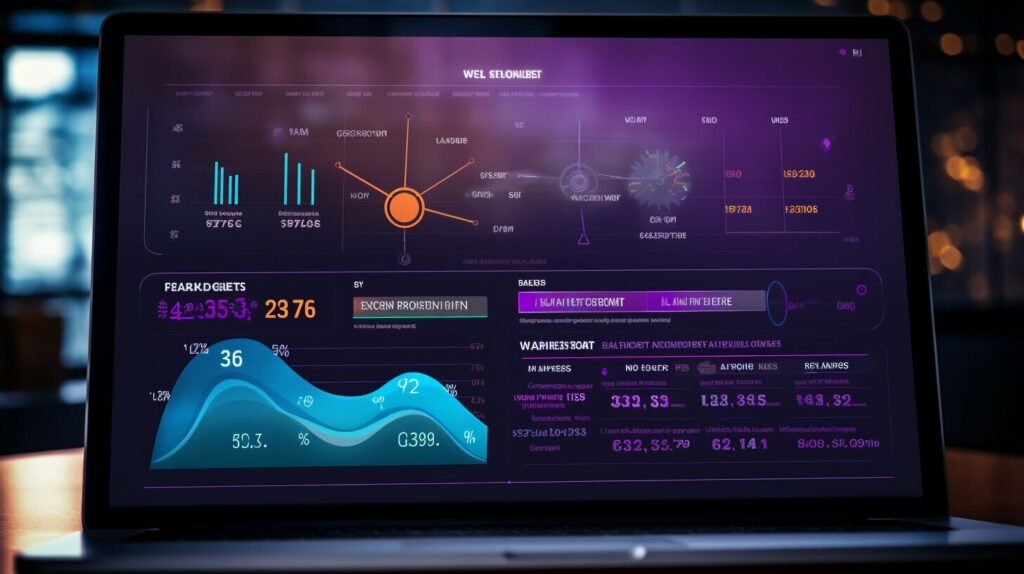Effective marketing campaigns rely on a thorough understanding of their impact. While traditional marketing techniques can often be measured through sales figures or advertising reach, below-the-line (BTL) marketing poses unique challenges to marketers seeking to quantify its true impact.
BTL measurement and analysis are imperative to determine campaign effectiveness. By using various tools to measure metrics and analyze data, marketers can refine their strategies to achieve optimal results.
Key Takeaways
- Measurement and analysis are crucial in determining BTL campaign effectiveness.
- BTL marketing poses unique challenges in measuring its impact.
- Various tools and techniques can be used to measure BTL metrics and analyze data.
Understanding BTL Marketing and its Challenges
BTL or Below-The-Line marketing encompasses a range of non-traditional advertising methods, such as direct mail, email marketing, experiential events, and influencer marketing. Unlike Above-The-Line advertising, which targets a mass audience through mediums such as TV or print ads, BTL marketing is more targeted, personalized, and utilizes different platforms.
However, one of the challenges marketers face with BTL marketing is measuring its effectiveness. Unlike ATL advertising, which is easier to track through metrics like reach and impressions, BTL marketing requires specialized measurement tools as it relies on individual interactions between the brand and the consumer.
As such, marketers need to utilize various BTL measurement tools and techniques to analyze and quantify the effectiveness of BTL campaigns. These tools can provide valuable insights into customer behavior, engagement levels, and overall campaign success.
Understanding BTL Marketing Challenges
While BTL marketing has several benefits, including targeted messaging and personalization, its success is reliant on several factors that can make measurement challenging. These factors include:
- The lack of standardized metrics
- Varying levels of interaction and engagement methods
- The need for specialized measurement tools
- The need to measure both quantitative and qualitative data
These challenges can make it difficult for marketers to gain an accurate understanding of the effectiveness of their BTL campaigns.
Tools for BTL Marketing Measurement
To overcome the challenges of measuring BTL marketing, marketers need to utilize various measurement tools, such as:
| Tool | Description |
|---|---|
| Customer Surveys | Help to gather qualitative data from customers, such as their feedback, opinions, and thoughts on the campaign. |
| Social Media Analytics | Provide insights into customer engagement levels and help to identify popular content, trends, and sentiment. |
| Email Marketing Analytics | Provide data on email open rates, click-through rates, and conversion rates, helping to optimize email campaigns. |
| Experiential Marketing Analytics | Provide data on customer interaction and engagement levels with the brand, helping to measure overall campaign success. |
By utilizing specialized measurement tools and techniques, marketers can gain a better understanding of the effectiveness of their BTL campaigns and make data-driven decisions to optimize their strategies.
 Image source: seowriting.ai
Image source: seowriting.aiImportance of BTL Measurement and Analysis
BTL marketing is a powerful tool for engaging customers in a personal, interactive way. However, in order to ensure effectiveness and maximize ROI, it is essential to measure and analyze its impact. This is where BTL measurement and analysis come in.
Without proper measurement, it is impossible to evaluate the success of BTL campaigns and adjust strategies accordingly. BTL measurement involves collecting and analyzing data to gain valuable insights into campaign performance. This includes metrics such as reach, engagement, leads generated, and overall impact.
Reporting is a crucial aspect of BTL measurement, as it provides a clear picture of campaign success and identifies areas for improvement. By analyzing BTL metrics, marketers can make data-driven decisions and optimize their campaigns for better results.
BTL measurement and analysis also helps to justify the investment in BTL marketing. By demonstrating the value and impact of BTL campaigns, marketers can secure budget and resources for future initiatives.
Overall, BTL measurement and analysis are essential for successful BTL marketing. By leveraging the right tools and techniques, marketers can gain valuable insights into campaign performance and optimize their strategies for maximum impact.

Key BTL Measurement Techniques
There are various measurement techniques used in below-the-line (BTL) marketing that can provide valuable insights for marketers. These techniques help evaluate the performance of BTL campaigns, measure the ROI, and optimize future campaigns to achieve maximum success. Here are some of the key BTL measurement techniques:
| Technique | Description |
|---|---|
| Response Rate Analysis | This technique measures how many recipients responded to a particular BTL campaign. By analyzing the response rate, marketers can evaluate the campaign’s effectiveness and adjust future campaigns accordingly. |
| Conversion Rate Analysis | This technique measures the number of recipients who took the desired action after interacting with a BTL campaign, such as making a purchase. By analyzing the conversion rate, marketers can evaluate the campaign’s impact on sales and optimize future campaigns to increase conversions. |
| Engagement Analysis | This technique measures how engaged recipients were with a particular BTL campaign, such as the amount of time spent interacting with the campaign. By analyzing engagement, marketers can determine the effectiveness of their messaging and adjust future campaigns to increase engagement. |
Other BTL measurement techniques include reach and frequency analysis, brand recall analysis, and brand perception analysis. Each technique provides valuable insights into BTL campaign performance and helps optimize future campaigns for maximum success.
Image source: 
BTL Measurement Tools and Software
To effectively measure and analyze BTL marketing, marketers need to have access to the right measurement tools and software. With the advancement of technology, there are numerous options available to choose from.
One popular tool for BTL measurement is Google Analytics , which provides insights into website visits, click-through rates, and other website metrics. Another useful tool is Tableau , which offers data visualization and analysis tools to help marketers understand their BTL campaign performance.
Other BTL measurement software options include Mixpanel , Ontraport , and LinkedProspect , which provide features such as A/B testing, lead capture, and customer segmentation.
When considering BTL measurement tools and software, marketers should keep in mind their specific needs and goals. What metrics are most important to measure? What level of analysis is required? It’s essential to choose the right tool to extract the most valuable insights.
| Pros | Cons |
|---|---|
| User-friendly interface | May require significant investment |
| Efficient and accurate data analysis | May not offer all necessary features |
| Can provide insights for future campaigns | May take time to learn and set up |
Regardless of the tool or software chosen, it’s important to regularly track and analyze BTL metrics to evaluate the effectiveness of campaigns and make data-driven decisions for future marketing efforts.

Data-Driven Strategies for BTL Success
Data-driven strategies are essential for the success of BTL marketing campaigns. By analyzing BTL data, marketers can identify what works and what doesn’t. This insight allows for the optimization of campaigns for maximum effectiveness.
One effective BTL data analysis technique is A/B testing. This method allows marketers to compare two versions of a campaign and determine which performs better. For example, a retailer could create two versions of an email campaign, one with a discount code and one without. By measuring the results of each campaign, they can determine which version is more effective and implement that in future campaigns.
Another technique is segmentation analysis, which groups customers based on shared characteristics and behaviors. This analysis can identify specific segments that respond better to certain BTL tactics, allowing marketers to tailor campaigns to specific individuals or groups.

BTL measurement tools and software can assist in data-driven strategies. These tools can automate the analysis process, reducing the potential for human error and providing faster results. They can also create visual representations of campaign performance, including charts and graphs, which make it easier to understand and communicate data to stakeholders.
It’s important to note that data-driven strategies should not be stagnant. Marketers should continually analyze campaign performance and adjust strategies as necessary. This ongoing analysis allows for continual improvement and optimization of campaigns.
Best Practices for BTL Measurement and Analysis
Effective BTL measurement and analysis is critical for success in marketing. It enables marketers to evaluate the performance of their campaigns and make data-driven decisions to optimize future initiatives. Here are some best practices to follow when measuring and analyzing your BTL campaigns:
| Best Practice | Explanation |
|---|---|
| Set clear objectives | Ensure that you have specific, measurable objectives for your BTL campaign. This will help you determine which metrics to track and analyze. |
| Use multiple metrics | Don’t rely on a single metric when measuring campaign success. Use a combination of metrics that are relevant to your campaign objectives. |
| Track metrics consistently | Establish a consistent tracking system for your metrics. This will enable you to get an accurate picture of your campaign’s success and make informed decisions based on the data. |
| Utilize the right tools | Choose BTL measurement tools that align with your campaign objectives and metrics. Consider factors such as ease of use, cost, and reporting capabilities. |
| Analyze data regularly | Regularly reviewing your campaign data will help you identify trends and areas for improvement. Utilize BTL analysis techniques to draw insights from your data. |
| Continuously optimize | Use the insights gained from your BTL measurement and analysis to optimize future campaigns. Continuously testing and refining your approach will help you achieve greater success over time. |
By following these best practices, you can ensure that your BTL campaigns are effectively measured and analyzed. This will enable you to make informed decisions and achieve greater success in your marketing initiatives.

BTL Measurement Tools and Software
Effective BTL measurement and analysis require the right tools and software. There are various options available in the market today that can help marketers streamline their measurement and analysis processes. Here are some of the most popular tools and software:
| Tool/Software | Features | Benefits |
|---|---|---|
| Google Analytics | – Audience insights – Traffic sources – Conversion tracking – Customizable dashboard | – Free to use – User-friendly – Integrates with other Google tools |
| AdRoll | – Multi-channel measurement – Cross-device tracking – Customer journey mapping – Real-time reporting | – Helps optimize ad spend – Can identify high-performing channels – Offers personalized insights |
| Brandwatch | – Social media monitoring – Sentiment analysis – Influencer identification – Customizable reporting | – Helps measure social media success – Can identify brand advocates – Offers actionable insights |
Choosing the right BTL measurement software depends on several factors, including budget, business needs, and campaign goals. It is important to evaluate each option carefully before making a decision.
Integration with existing systems is critical when choosing BTL measurement software. Marketers should look for solutions that can integrate with their CRM, marketing automation, and other relevant tools.
Keep in mind that the software is only as effective as the data that goes into it. Therefore, it is important to implement a standardized data collection process that ensures accuracy and consistency.
Conclusion
BTL Measurement and Analysis is an essential aspect of any successful marketing campaign. By leveraging various measurement tools and techniques, marketers can gain valuable insights into their campaigns’ effectiveness and make data-driven decisions for optimization.
Through this article, we have discussed the challenges marketers face in BTL marketing, the significance of BTL metrics and reporting, and explored various measurement techniques and software solutions. We have also highlighted the importance of data-driven strategies and provided best practices for effective BTL measurement and analysis.
Real-life case studies and success stories have illustrated the impact of BTL measurement and analysis on campaign effectiveness. By following the tips and recommendations presented in this article, marketers can optimize their BTL marketing strategies and achieve greater success. These insights not only highlight the value of tailored messaging and audience engagement but also provide a successful BTL campaigns overview that can serve as a blueprint for future efforts. By leveraging these proven strategies, brands can create memorable experiences that resonate with consumers on a personal level. Ultimately, this leads to increased brand loyalty and a stronger market presence.
Stay Ahead of the Game
As the marketing landscape continues to evolve, staying up-to-date with the latest measurement techniques and software solutions is crucial. By utilizing BTL measurement and analysis effectively, marketers can make data-driven decisions that lead to successful campaigns and happy customers.
What are the Key Factors to Consider When Evaluating Portfolio and Client Testimonials?
When assessing portfolio and client testimonials, several factors for evaluating portfolio and client testimonials should be taken into account. Firstly, the credibility and authenticity of the testimonials should be verified to ensure they are genuine. Secondly, the relevance of the testimonials to your specific industry or niche is crucial, as it reflects the expertise of the professionals involved. Furthermore, the overall quality and impact of the testimonials should be considered, including the use of persuasive language and concrete results. Lastly, a diverse range of testimonials, including those from different client types and project scopes, is essential to capture a comprehensive perspective.
How Can Personalization and Customization Improve BTL Measurement and Analysis?
Personalization and customization are key strategies for personalized btl marketing. By tailoring messages and offers to specific individuals or target segments, businesses can boost engagement and conversion rates. Moreover, this approach allows for more accurate measurement and analysis of BTL campaigns. Tracking customer preferences, behaviors, and responses enables the identification of successful tactics, leading to informed decision-making and improved campaign results.
FAQ
Q: What is BTL Measurement and Analysis?
A: BTL Measurement and Analysis refers to the process of evaluating and analyzing the effectiveness of below-the-line (BTL) marketing activities. It involves measuring and interpreting data to understand the impact of BTL campaigns and make informed marketing decisions.
Q: Why is BTL Measurement and Analysis important for marketers?
A: BTL Measurement and Analysis is crucial for marketers as it helps them gauge the success of their BTL campaigns and optimize their marketing strategies. It provides insights into consumer behavior, campaign performance, and the ROI of BTL activities.
Q: What are the challenges faced in measuring BTL marketing effectiveness?
A: Measuring BTL marketing effectiveness can be challenging due to the lack of standardized metrics and the difficulty in attributing specific actions to BTL activities. Additionally, capturing accurate data and analyzing it in a meaningful way can pose challenges.
Q: What are some key BTL measurement techniques?
A: Key BTL measurement techniques include performance analysis, tracking customer response rates, conducting surveys and focus groups, and analyzing sales data. These techniques provide valuable insights into the effectiveness of BTL campaigns.
Q: What tools and software are available for BTL measurement and analysis?
A: There are various tools and software available for BTL measurement and analysis, such as BTL measurement software, campaign tracking tools, data analytics platforms, and CRM systems. These tools help marketers collect, analyze, and interpret data for better decision-making.
Q: How can data-driven strategies enhance BTL marketing success?
A: Data-driven strategies utilize insights gained from BTL measurement and analysis to optimize campaign targeting, messaging, and delivery. By leveraging data, marketers can make informed decisions and tailor their BTL activities to better resonate with their target audience.
Q: What are some best practices for BTL measurement and analysis?
A: Some best practices for BTL measurement and analysis include setting clear objectives and defining key performance indicators (KPIs), leveraging multiple measurement techniques, using reliable data sources, and regularly reviewing and adapting strategies based on insights.
Q: Can you provide examples of BTL measurement and analysis success stories?
A: Yes, there are many real-life case studies and success stories where BTL measurement and analysis have contributed to campaign effectiveness. These stories highlight the impact of data-driven strategies and the importance of accurate measurement in achieving marketing goals.
Q: What is the conclusion of the article on BTL Measurement and Analysis?
A: The conclusion of the article emphasizes the significance of utilizing data-driven strategies and measurement techniques in BTL marketing. It emphasizes the importance of leveraging insights from BTL measurement and analysis to optimize campaigns and achieve success in marketing efforts.






